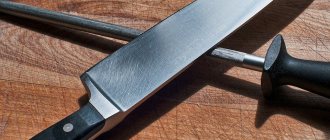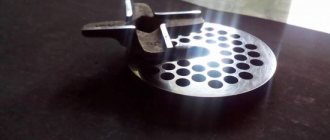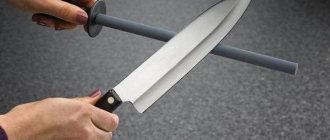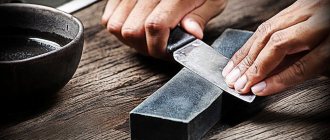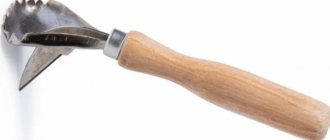- July 22, 2020
- Tools and equipment
- Andrey Sky
Almost any knife, especially for household use, requires regular restoration of the cutting edge. Due to constant mechanical impact, the tip becomes dull and deformed, which is why its performance is lost. Therefore, the sharpening process is a mandatory technological operation as part of the maintenance of this tool. This procedure can be performed with makeshift tools, but it is much more convenient to use special equipment like a sharpening machine. How to sharpen knives correctly on such a unit? Several aspects of the operation need to be taken into account at once - this applies to preparatory work and setting up equipment in compliance with safety rules.
When is it necessary to sharpen a knife?
If the tool is in good condition and fully ready for cutting operations, there is no point in adjusting its edge. On the contrary, performing this procedure may disrupt the initially correct edge geometry and reduce the quality of the cut.
But there are signs that clearly indicate that the use of an electric knife sharpener or other tool is required to restore the tip to working condition. For example, if small particles of metal are chipped off the edge. Some models of knives, depending on the material used, even pose a risk of injury in a dull state.
Another sign of a non-ideal state of the tip is the poor quality of the cut in principle. If the knife does not cut, but tears the product, it is necessary to correct it. The essence of the sharpening operation will be to restore the desired blade profile. In other words, the rounded edge of the tip must be given the shape of a cone.
Types of wear
Typically, the technology of how to properly sharpen kitchen knives is a set of measures consisting of coarse and fine sharpening with possible subsequent polishing if the material of the tool allows the sharpness to be increased by the final procedure. For high-quality steels, before a noticeable loss of cutting properties, the tool is capable of making 200–500 cuts on food products and maintaining an acceptable sharpness for a long time after that.
Intervention in the edge geometry may only be necessary in case of severe wear once every few years, except in emergency cases. The main damage that leads to the need to remove large amounts of metal with abrasives occurs mainly when using the blade as a lever. Such stress can even cause the blade to bend or break.
Great forces on hard objects are no less destructive to the knife. Attempts to cut ice, bones, or accidentally hitting the side of the pan lead to chipped edges. The fabric can also be damaged as a result of severe corrosion, usually from exposure to food acids or from high temperatures and aggressive chemicals in the dishwasher. The corrosion pits that form on the edge require its complete restoration.
To avoid such damage, you should follow simple rules:
- use tools appropriate to the task;
- use only wooden surfaces as boards;
- cut without lateral movements;
- wash the blade immediately after use;
- Keep each separately clean and dry.
How to choose a sharpening machine?
For household work, it is best to use electric models for household use. Today these are universal units with a desktop installation method that cope with the restoration of blades not only of knives, but also of axes, chisels, all kinds of cutters and scissors.
It is advisable to give preference to knife sharpening machines with an adjustable angle, which will initially improve the quality of the operation. Moreover, it is important to pay attention to the configuration of the working equipment. Firstly, much more sharpening capabilities will be provided by a machine that allows the use of an abrasive disc and tape. Secondly, it is more convenient to use a setup with two circles on different sides. The fact is that the process of point correction may require the use of abrasives with different degrees of grain size. To avoid wasting time on reinstalling them when moving from one circle to another, it makes sense to take care in advance about the possibility of installing two elements simultaneously from different sides.
The best metals - how to sharpen?
When sharpening a knife, everything matters: effort, tilt, beginning and end point of movement. and it all depends on the quality of the steel.
Damascus steel knife
This name makes any connoisseur of edged weapons start to feel a rapid heartbeat. Meanwhile, Damascus knives also tend to become dull. Unless, of course, they are under glass in a home collection. There can be no talk of any electric sharpeners. The blade consists of alternating soft and hard grades of steel, which with such rough intervention will simply lose their unique properties. Therefore, only hand sharpening.
Before starting work, you need to understand how hard the material is. This can be determined by looking at the sharpening angle. The sharper it is, the harder the steel.
Knife blade sharpening technology
Whatever material you use to sharpen, Damascus knives are sharpened only along the blade. This is a golden rule; neglecting it will simply ruin the blade. And it is best to sharpen this unique steel with a fine-grained whetstone. Moreover, you need to start from larger grains, gradually moving to “velvet”.
If there are nicks on the tip, you will have to grind off the entire length of the edge.
IMPORTANT! If you want to “gloss” and polish the slopes, you need to do this not after, but before sharpening the cutting edge. Otherwise, you will simply round the edge.. In this video, the master gives an example of sharpening knives made of Damascus steel, without claiming that the method is ideal
In this video, the master gives an example of sharpening Damascus steel knives, without claiming that the method is ideal.
Damask steel knife
No less eminent fellow in terms of elite blade. The main feature is the highest hardness of the alloy. With the tip of a damask knife you can cut a steel nail or corner.
Therefore, sharpening such a blade should be taken very seriously. Damask steel is sharpened on a wet whetstone, first with coarse grains (the so-called roughing stone). Then we move on to sharpening (fine grit), and bring the blade to the ceramic surface.
The process is long, but the result is worth it.
Watch the video: Sharpening a damask knife using a hand sharpener. At the end of the video there is a demonstration of the tip of the blade.
Features of professional sharpening machines
Such equipment has several technical and operational differences from household analogues. But it’s worth emphasizing right away that the cost of this machine can be 2-3 times higher than models for home use.
So, we are talking about more productive, functional and precise units that can confidently adjust the shape of an edge made of tool and high-speed steel. As a rule, professional electric knife sharpeners have a durable metal base, a balanced rotor, almost always the ability to install two wheels, and a powerful three-phase motor.
In terms of functionality, it is worth emphasizing the possibility of adjusting the reach, point-by-point adjustment to the dimensions of the tool being processed, and automatic wetting of the working equipment, which protects it from overheating.
Lesson 6. Selecting a set of whetstones
In this lesson I tell you why you need to have several sharpening stones in a set, how many there should be and how to choose them.
Why do you need to have several whetstones?
First, the knife you are going to sharpen may be dull to varying degrees. If you only need to sharpen a slightly dull, but initially well-sharpened knife, it makes no sense to use a rough stone. Otherwise, you will kill all the sharpening and you will have to re-shape the cutting wedge of the blade. Therefore, it is better to start sharpening a slightly dull knife on a medium-grain stone. If the sharpness of the blade is completely lost, as often happens with inexpensive kitchen knives that do not require sharpening, you will use a medium-grain stone to restore the shape of the blade until the next morning, so a coarse stone will help here. Accordingly, a set of several sharpening stones will allow you to more accurately select the desired grit for the existing knife to be sharpened.
What makes a knife cut?
Secondly, let's remember why a knife cuts in the first place. If you look at it under a microscope, you can see the microscopic scratches that the abrasive particles of the whetstone left on the blade. And the blade itself, under high magnification, will look like a saw. This same microsaw cuts the material. In fact, the cutting mechanism is similar to the sawing mechanism.
So, a coarse-grained stone leaves rough scratches on the blade. The resulting “saw” will cut very willingly and aggressively, but at the same time it will quickly lose its sharpness. In order for the knife to retain its blade shape and its cutting properties longer, you need to grind the microsaw and make its “teeth” finer. If, after a super-rough stone, you go straight to the finishing super-fine stone, grinding, again, will take a lot of time. It is most effective to grind the blade gradually, moving from coarse stones to medium ones and then to fine ones. This is why you need to have a set of several stones with different grain sizes.
How many sharpening stones should there be in a set?
A complete set is considered to be a set of 5 stones: very coarse, coarse, medium, fine, very fine. Or in the English version: extra coarse, coarse, medium, fine, extra fine. I recommend it to fans of sharpening and those who like to meditate and work magic on knives. A simpler and more practical option - made of three stones - coarse, medium, fine. This set provides an optimal time/result ratio and is suitable for practical people. And the camp version is made of two stones, or rather, one stone or sharpening tool with two different grits on both sides, usually coarse/medium.
How to choose the grit of sharpening stones?
It is optimal if the grain size of “neighboring” stones in the set differs by 2-3 times. For example, my set of Japanese water stones looks like this: 220, 400, 1000, 3000, 8000. It is not worth taking stones with similar grain sizes such as 200, 300, 400, 600, 800. If you have a set of three stones, then the outer ones of the extra prefix disappear, and what remains is coarse, medium, fine. Using my stones as an example, these are 400, 1000, 3000. Well, or you can take very rough, rough, medium, that is, 220, 400, 1000.
The logical question is: at what point should you switch to the next stone with a finer grain size? The answer to it is in the next lesson, but for now watch the same thing in the video:
The best manufacturers of sharpening machines
In the budget segment, for simple sharpening tasks you can find good offers from domestic manufacturers. These are machines costing up to 3-4 thousand rubles. from brands such as “Vikhr”, “Kraton”, “Caliber”, etc.
The middle and most popular segment is represented by models with a price tag of approximately 5 to 10 thousand from Bosch, Metabo and Makita. According to reviews, one of the best knife sharpening machines in this group is the Bosch GBG 60-20 model. It has balanced characteristics and decent German workmanship.
Private craftsmen and industrial workers will be interested in professional models. This is a narrow, but technologically developing class of sharpening machines from companies such as Inforce and Proma in the BKL line.
Electric sharpeners
Electric sharpeners are a modern alternative to whetstones and whetstones. These devices can be adjusted to suit different types of blades. The knife is guaranteed not to be damaged. Sharpening one product, often together with grinding, takes up to 2-3 minutes.
Electric sharpeners differ in power levels and additional equipment. The most expensive and professional sharpeners are equipped with three grooves with different disks. They provide a three-step process and not only sharpen the cutting edge, but also polish it.
An expensive tool is necessary when you need to sharpen ceramic and exclusive products made from elite materials. Ceramic kitchen knives have become popular, but they are difficult to sharpen without preparation. There is a risk of crumbling and deforming the cutting part.
Abrasive wheel selection options
This consumable material for a processing machine is available in a wide range. The sharpening wheel specifically for a knife should be designed for working with steel and the possibility of finishing correction.
The shape of the profile is fundamentally important for working with sharpening. In this case, equipment with a straight profile is used, which is optimal for straightening the blade.
The grit size will determine what type of finish a particular abrasive wheel can provide. For a sharpening machine used to correct a knife blade, almost all types of fractions can be used. Usually there are three ranges - from 400 microns, from 1000 microns and from 5000 microns. Accordingly, coarse, medium and fine sharpening is provided. Sometimes you can limit yourself to just finishing touches if the blade requires only minor editing.
The type of abrasive itself is equally important. Although knives are not overly demanding tools in terms of machining and dressing, today it is better to give preference to the more durable and efficient alumina blades. This material is hard and resistant to damage.
About ceramic knives
For their manufacture, they do not use metals, but zirconium dioxides during dry pressing and very long exposure at high temperatures. Their blade has great hardness, but is fragile. It cannot be hit, thrown, or bent.
Due to its thin and highly hard blade, a ceramic knife cuts vegetables, fruits, fish, and meat well without corroding.
But they should not cut bones, thick skin of zucchini, melons, watermelons, make blows, or work on hard surfaces made of glass, porcelain and other materials.
How to sharpen a ceramic knife
Thanks to its durable blade, if the operating rules are followed, such a blade can work without sharpening for a year or longer. But over time, its edge will still wear out and require fine-tuning.
It should be taken into account that ceramics can only be processed with a special tool with a fine diamond coating. Ordinary sharpeners will only ruin it.
It is not recommended to sharpen ceramic products at home without the appropriate equipment and practical skills. It is better to take it to a specialized workshop for these purposes.
For those who like to experiment with this issue, I recommend watching the video by owner Andrey Atkin “Sharpening a ceramic knife.”
Useful products
- Leakproof water bottle 550ml
- Non-contact wiring indicator with flashlight
- Tool for opening the tablet case
How to check the grinding wheel?
Whatever wheel is used in the work, it must be carefully checked before performing the operation. The audit must begin with a visual inspection. The item should not have the slightest crack or even chip.
Next, a check is performed on the machine. For this procedure, it is better to use a professional knife sharpening machine, which provides more effective safety features and customization options. On it, in particular, it will be possible to check the abrasive wheel for runout. This defect is expressed in vibrations, when, upon external observation, the outer edge of the disk moves away from the center to the sides. If such a flaw occurs, then the abrasive will need to be corrected with a special diamond device.
Let's summarize?
At this point, the sound track ended as expected, Shufutinsky stopped warming up his baritone, the characteristic hiss of the record was heard, and now all the sharp objects in the house are in perfect condition...
So what should you remember when starting sharpening?
- Let's decide on a goal.
- Choosing the right type of sharpening machine.
- We make a choice in favor of the most convenient type of sharpening for us.
- We handle the unit carefully, otherwise it may become damaged or break, and this applies not only to the sharpening process, but also to handling kitchen utensils in general.
- Remember about the angle of inclination when sharpening.
- We sharpen ceramic products no more than twice a year, or even less! If the presented conditions are met, ceramic knives will always be in excellent condition!
General sharpening technology
First of all, you need to consider the operation from the outside. It is usually performed in two stages.
Initially, a smooth edge of the chamfer is formed so that it is sharp and without external defects. We can say that this is a rough sharpening, during which the general geometry of a sharp blade is simulated without the previous roundness. At this stage, wheels with a large grain fraction can be used.
The second stage involves performing a much more important operation to restore the blade. How to properly sharpen knives on a sharpening machine as part of the finishing edit? Much will depend on the experience of the performer, but in any case, you should focus on the existing shape of the blade, which was modeled during rough processing. At this stage, small irregularities and burrs are usually removed that cannot be carefully removed with large-format abrasive.
Technique for sharpening knives on a machine
Now you can move on to the most important stage - direct work with the knife.
It is advisable to position the blade against the direction of movement of the disk, which will prevent the metal from crumbling at the edge and minimize the risk of the same burrs forming. The only disadvantage of this method of positioning the knife is the risk of cutting it into a circle, which will ruin the tip at one point and may well deform the entire knife. Therefore, at first, beginners can experiment with positioning the knife in the direction of the abrasive stroke.
At the editing stage, additional devices will be required for sharpening the knife on a sharpening machine. We are talking about a whetstone with the finest grain, which will allow you to carefully trim the edge in certain areas. The process of fine-grained sharpening on a machine should be performed with a minimum number of movements. There is a high risk of knocking down a chamfer, which will ruin the entire result. You need to act carefully and balanced - along the entire length of the blade. Both sides are processed in this way so that the shiny surface of the knife is equally visible.
Methods for checking the blade tip
After carrying out the work, you need to check how sharp the blade is. Several methods are used for this.
On paper
Try to cut a sheet of paper while holding it with one hand. If you can do it without problems, the sharpening is good. A sharp blade will cut the sheet under its own weight.
On a tomato
Often the sharpness of kitchen blades is tested on tomatoes. If it is blunt, the vegetable will be crushed. You need to put it on the table in front of you, try to cut the tomato with the blade horizontally without holding it with your hand. A sharp blade will easily cut a vegetable.
Checking knife sharpening on tomatoes
Testing on hand hair
One of the testing methods that people often use after turning tools. To do this, the knife is pressed effortlessly against the skin of the hand. It should be easily passed through the hair. If the hairs are cut, the blade is sharp, suitable for various types of work.
Everyone uses knives. However, these tools become dull over time, making it impossible to work with them. To restore the sharpness of steel, you can use different devices. Taking into account the angles for different types of knives, you can carry out the work yourself.
What is the correct knife sharpening angle?
The value is not universal, so you should focus on the specific type of knife and its application. It can be said that in the first stage of rough modeling of the geometry, some metal should be left for later removal for straightening purposes. When final sharpening knives, the angle is usually kept in the range from 7° to 45°. Moreover, average values of about 25° usually apply to kitchen tools, and the upper bar, up to 50°, applies to special models for tourist and hunting purposes.
Basic methods
There are several effective methods for sharpening knives at home; for this you will need to purchase simple tools.
Bar
Bar - used most often, there are several types, the differences lie in the number of abrasive grains per 1 sq. cm. First, bars with a minimum number of grains are used; for final sharpening, products with the maximum number of abrasives are suitable. For foreign-made products, the relevant information is provided in the instructions. When purchasing domestic products, information should be clarified in the store.
Mechanical sharpener
This option is ideal for sharpening kitchen knives. The process is quite fast, but the quality is not ideal. This method is not suitable for sharpening sports knives intended for hunting models.
Electric sharpener
The electric sharpener is designed to produce sharp blades, the effect is achieved by automatically detecting the angle. This option is ideal for home knives and can be used in catering organizations. There is a wide range of models on sale at different prices. Preference should be given to expensive, most advanced devices.
Musat
Musat - used to sharpen the edge. The shape of the product resembles a file with a handle. The products come in sets and are often confused with conventional sharpening tools.
It is important to consider that the grinding stone is useless for sharpening very dull knives.
Sharpener "Lansky"
The sharpener is designed for sharpening small and medium-sized knives. The design allows the procedure to be performed at any angle. It consists of a rod and 2 connected corners. They simultaneously function as a vice for the blade and a scale for selecting the angle.
Features of sharpening knives on a manual machine
Today there are many purely mechanical sharpening machines without an electric drive. They have a wide variety of design options and functionality. But when handling such a tool, it is important to consider several nuances. Firstly, a manual knife sharpener is usually mobile, which means that it will need to be well secured each time. This should be done on a workbench or other hard and stable table. Secondly, the sharpening process is performed with translational movements in only one direction. It should also be noted that with intensive use of manual sharpeners with a configuration of two V-directional abrasive stones, the knife will wear out much faster than when working with an electric machine.
How does the blade get dull?
We buy a sharp knife at the store, but over time it inevitably becomes dull if, of course, we work with it. Why does this happen, since the tool is made of good steel and sharpened at the factory? The process takes place at several levels:
- Microscopic, when particles of steel are ground off the cutting edge during friction with the material, making the edge less sharp. You can't see it, but you can feel how more and more pressure is required to cut over time.
- Macroscopic, when the tip encounters solid inclusions, such as grains of sand, particles of stone or metal. They are found in almost any material. The edge either moves the obstacle away or moves away itself, while crumpling.
- If the blade is used inappropriately, its blade can be damaged beyond recognition. This means unscrewing screws, digging soil, etc.
As a result, the working part of the blade is deformed, the edge loses its sharpness and the tool becomes less and less suitable for work. Gradually, hardened steels crumble, and softer and more ductile steels begin to curl.
Rice. 1. The process of blunting and sharpening a knife: 1. When working with a knife, the shape of the cutting edge changes randomly. 2. During the sharpening process, we return the specified shape of the cutting edge or change it. 3. And we give it smoothness, finally removing the burr.
To return the knife to working condition, it is necessary to eliminate the resulting deformation and restore the correct shape of the blade.
What should you know about sharpening stones?
Comprehensive maintenance of knives, even if you have a machine with abrasive wheels, is unlikely to do without a touchstone. This granular block will allow, if necessary, to correct the result obtained on the machine, as well as support the operation of the tool in the field, if necessary.
In addition, some electric units are fully equipped with such bars as consumables. How to sharpen knives correctly on this type of sharpening machine? The principle is somewhat similar to mechanical and electrical machines on circles. The only difference is that the operator does not need to make any special efforts. The main work will be done by the device itself. The maximum that will need to be done is to ensure external control of the process.
Of course, a lot will depend on the sharpening stone itself. They are ceramic, abrasive and natural. If we are not talking about using the product as part of an electric machine, then before work it is better to moisten it with a soap solution. This technique will improve glide and prevent intense spraying of small particles from metal and abrasive.
How do you know when it's time to sharpen your knife?
Every knife, even if it is made of first-class metal with maximum strength, may one day have a dull blade. To understand that it needs to be refreshed, you need to do a basic check. For example, using the following three methods.
- Take a hemp rope, fold it four times and try to cut it with a knife. If everything worked out, then the blade does not need sharpening yet. If the rope remains intact, it’s time to take out the tools.
- If you have a needle file (miniature file) at home, run it along the blade of the knife. If, with strong pressure, the blade scratches the surface, and with weak pressure, it slides, then everything is in order.
- If you have neither rope nor a file, the classic method with paper will come to the rescue. Take a regular A4 sheet, fold it and try to cut it on the fold with a knife. If the blade slides smoothly and without much effort, then the knife does not need to be sharpened. Otherwise, it's time to get down to business.
- Try cutting a tomato. Doesn't it cut and turns into tomato paste? This means your knife has been in need of sharpening for a long time.
Safety requirements
Using a tool sharpening machine is a very reasonable and convenient way to solve the problem of dull blades. But we must not forget about safety. How to properly sharpen knives on a sharpening machine without harming your health? First of all, you can only work on proven and serviceable equipment, as well as on tested equipment, as already mentioned. During the operation, sudden manipulations and changes in the operating mode are excluded. All actions are performed smoothly and without jerking. Also, in the room where sharpening is carried out, there must be active ventilation. Small particles of abrasive and metal released during such operations must be removed immediately, as they pose a threat to the respiratory system.
Step-by-step instructions for sharpening with a whetstone
We invite you to watch this video, which shows the process beautifully and in detail:
Sharpening a knife - the basics, concise, complete, accessible. The simplest correct algorithm for sharpening knives
Let's talk in more detail about how to sharpen a knife yourself. This procedure requires a sharpening stone, water and, in fact, a dull specimen.
If you are a beginner, then it is quite logical to practice sharpening not on the most expensive and favorite tools, but on old and irrelevant ones. Once mastery comes to you, you will achieve the sharpness of the blades of all the tools in the house.
Your workplace should be well lit and you should be able to see your tools clearly. If your vision is not very good, use glasses or a magnifying glass - you should not miss the moment when sharpening should be stopped to avoid excessive removal of metal from the blade.
How to lubricate the bars? The most common option is water, but some experts use oil for this. In our article we will talk about wetting tools with water.
Sit upright and comfortably, wet the tools with water. The angle at which you should hold the knife in relation to the sharpening stone should be approximately 22°. Use either a coarse-grained whetstone (if you decide to sharpen and grind in stages) or a medium-grained one (in one stage).
Determining the angle at which you should hold the knife is quite simple in the following way: take a square sheet of paper. The angle of the sheet is 90°, bend it in half, you get a 45° triangle, in half again - so you get the desired angle. Insert the resulting paper triangle between the knife and the sharpening stone. This is the right angle. Remember and stick to it in the future.
Sharpening should be done with smooth, fairly slow movements, moving your hand steadily. Remember to keep your tools wet at all times. This way you will achieve perfect glide, while fine metal dust will not clog the pores of the sharpening stone, and the quality of sharpening will be at its best.
The sharpening stone is located on the table, hold the tool being sharpened with your right hand, press down on the edge with your left, and work away from you, moving from the handle to the tip of the blade.
Remember to maintain the angle, work smoothly with equal pressure. The cutting edge that slides along the block must be strictly perpendicular to the direction of movement.
For a good result, make fifty such movements (remembering to constantly wet the tools), then turn the knife over and repeat the work on the other side. There should be no dirt or dust left behind as you keep both tools wet at all times.
Some experts determine the readiness of sharpening a knife by the appearance of characteristic burrs on the edge of the blade.
Never run your finger over the blade to determine the level of sharpness; it may turn out to be sharper than you think, and injury may occur. Limit yourself to a visual inspection.
Well, let's move on to fine-tuning the knife? There are two options here. The first method has already been mentioned above - you should take a sharpening stone with a small grain size. The second option is musat.
Musat is a special steel rod with notches. Often included in kits. Musat is also used to sharpen a knife. Choose any of the proposed methods and bring the instrument to sharpness. You should work according to the technology described above.
If you want to achieve extraordinary sharpness, which can only be rivaled by a new razor, we suggest you use special abrasive pastes based on chromium oxide (such as GOI).
Apply an abrasive paste for grinding and polishing to a leather surface (for example, an old leather belt), and sharpen the blade on it (direction away from the cutting edge). The result will please you!
Now the best part - take a tomato and try to chop it finely, enjoy the flawless work of your hands, you have mastered sharpening.
